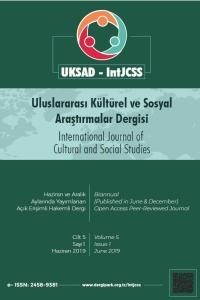Investigation of Smartphone Addiction Levels Among University Students
Investigation of Smartphone Addiction Levels Among University Students
The aim of this study was to investigate the smartphone addiction among
university students. Totally 490 students with mean age of 20.1±2.1 year
attending Çanakkale Onsekiz Mart University who volunteered to
participate. “Smartphone Addiction
Scale-Short Form” used to collect data. SPSS used to analysis. The results of
the study found all participants used smartphones and the most common reason
for smartphone use was determined as “browsing social networks” (51.9%). Daily
smartphone use was most commonly determined as 4-6 hours (36.3%). There was a
statistically significant difference found between smartphone use duration and
addiction points (p<0.05). Daily smartphone use of 9 hours or more caused
statistically significantly high addiction points compared to other daily use
durations. Additionally, there was a statistically significant positive
correlation between daily smartphone use duration and addiction points (r:0.339
p:0.01). In conclusion, daily smartphone
use of 9 hours or more had highest smartphone addiction points. In light of
this data, to prevent symptoms of smartphone addiction among university
students, physical and social activities should be planned to reduce the daily
smartphone use durations of students and it may be beneficial to encourage
students to participate in these activities.
Keywords:
Smart phone addiction, university, student,
___
- Abu-Jedy, A. (2008). Mobile phone addiction and its relationship with self-discloser among sample of students from University Of Jordan And Amman Al-Ahliyya University. Jordan Journal Of Educational Science, 4(2),137-50.
- Alosaimi, FD., Alyahya, H., Alshahwan, H., Al Mahyijari, N., Shaik, SA. (2016). Smartphone addiction among university students in Riyadh, Saudi Medical Journal,37(6),675-683
- Bianchi, A., Phillips, J. (2005). Psychological predictors of problem mobile phone use. Cyber Psychology and Behavior, 8(1)39-51.
- Billieux, J., Linden, M., Rochat, L. (2008) The role of impulsivity in actual and problematic use of the mobile phone. Applied Cognitive Psychology, 22:1195–1210.
- Chakraborty, K., Basu, D., Vijaya, KG. (2012). Internet addiction: Consensus, controversies, and the way ahead. East Asian Arch Psychiatry, 20:123-132.
- Cho, S., Lee, E. (2015). Development of a brief instrument to measure smartphone addiction among nursing students. Computers, Informatics, Nursing, 33(5),216-24.
- Cottler, LB. (1993). Comparing DSM-III-R and ICD-10 substance use disorders, Addiction, 88, 689– 696
- Grant, JE., Potenza, MN., Weinstein, A., Gorelick, D.A. (2010). Introduction to behavioral addictions. Am J Drug Alcohol Abuse, 36:233-241.
- Griffiths, M. (2000). Does internet and computer “addiction” exist? some case study evidence, Cyber Psychology and Behavior, 3(2), 211-219.
- Hakoama M., Hakoyama, S. (2011). The impact of cell phone use on social networking and development among college student. The American Association of Behavioral and Social Sciences,15,1-20.
- Haug, S., Castro, R.P., Kwon, M., Filler, A., Kowatsch, T., Schaub, M.P. (2015). Smartphone Use And Smartphone Addiction Among Young People İn Switzerland. Journal Of Behavioral Addictions 4(4), 299–307
- IDC (International Data Corporation), “Worldwide Smartphone 2012–2016 Forecast Update”, September, 2012.
- Kır, İ., Sulak, Ş. (2014). Eğitim fakültesi öğrencilerinin internet bağımlılık düzeylerinin incelenmesi. Elektronik Sosyal Bilimler Dergisi, 13 (51), 150-167.
- Kwon, M., Lee, JY., Won, WY., Park, JW., Min, JA., Hahn, J., et al. (2013). Development and Validation of a Smartphone Addiction Scale (SAS). Plos One, 8, e56936.
- Kyun-Gja Im, Soon-Jung Hwang, M-Ia Choi, Nam-Rye Seo, Ju-Nna Byun (2013). The Correlation Between Smartphone Addiction And Psychiatric Symptoms İn College Studentsj Korean Soc School Health, 26(2), 124-131.
- Noyan, CO., Darçın, A., Nurmedov, S., Yılmaz, O., Dilbaz, N. (2015). Akıllı Telefon Bağımlılığı Ölçeğinin Kısa Formunun üniversite öğrencilerinde Türkçe geçerlilik ve güvenilirlik çalışması. Anadolu Psikiyatri Dergisi, 16, 73-81
- Pawłowska, B., Potembska, E. (2011). Gender and severity of symptoms of mobile phone addiction in Polish gymnasium, secondary school and university students. Curr Probl Psychiatry, 12(4),433-38.
- Rounsavılle,B. J., Bryant, K., Babor, T., Kranzler, H., Kadden, R. (1993). Cross system agreement for substance use disorders: DSM-III-R, DSM-IV and ICD-10, Addiction, 88, 337–348.
- Sam-Wook Choı, Daı-Jın Kım, Jung-Seok Choı, Heejune Ahn, Eun-Jeung Choı, Won-Young Song, Seohee Kım And Hyunchul Youn, (2015). Comparison of risk and protective factors associated with smartphone addiction and Internet addiction, Journal of Behavioral Addictions, 4(4), 308–314
- Suliman, S.A., Mohammad, F.Q., Ismael, SA, Salaheldin, F.B., Adel, S.A. (2016). Smartphone addiction among university students in the light of some variables, Computers in Human Behavior, 61, 155-164
- Süt, K.H., Kurt, S., Uzal, Ö., Özdilek, S. (2016). Effects Of Smartphone Addiction Level On Social And Educational Life In Health Sciences Students, Euras J Fam Med, 5(1),13-19
- TSI (Turkish Statistical Institute) 2015. http://www.tuik.gov.tr/PreHaberBultenleri.do?id=21779 access date: 03.03.2018
- Wilska, T.A. (2003). Mobile phone use as part of young people's consumption styles. Journal of Consumer Policy, 26(4),441-463.
- Yılmaz, G., Şar, AH., Civan, S. (2015). Ergenlerde Mobil Telefon Bağımlığı İle Sosyal Kaygı Arasındaki İlişkinin İncelenmesi, Onlıne Journal of Technology Addıctıon & Cyberbullying, 2(2), 20-37
- Başlangıç: 2015
- Yayıncı: Mutlu TÜRKMEN
